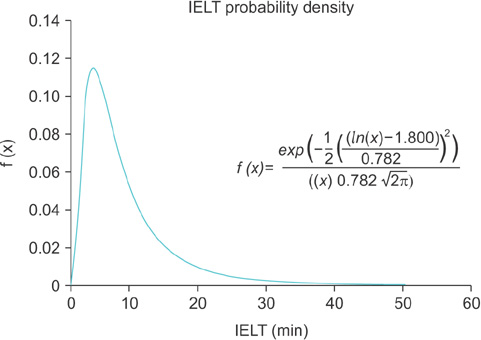Investig Clin Urol.
2016 Mar;57(2):119-128. 10.4111/icu.2016.57.2.119.
The mathematical formula of the intravaginal ejaculation latency time (IELT) distribution of lifelong premature ejaculation differs from the IELT distribution formula of men in the general male population
- Affiliations
-
- 1Department of Central Hospital Pharmacy, Viecuri Hospital, Venlo, The Netherlands.
- 2Division of Pharmacology, Utrecht Institute of Pharmaceutical Sciences, Utrecht University, Utrecht, The Netherlands. info@praktijkwaldinger.nl
- 3Department of Pharmacology and Physiology, Drexel University College of Medicine, Philadelphia, PA, USA.
- 4Private Practice of Psychiatry and Neurosexology, Amstelveen, The Netherlands.
- KMID: 2363134
- DOI: http://doi.org/10.4111/icu.2016.57.2.119
Abstract
- PURPOSE
To find the most accurate mathematical description of the intravaginal ejaculation latency time (IELT) distribution in the general male population.
MATERIALS AND METHODS
We compared the fitness of various well-known mathematical distributions with the IELT distribution of two previously published stopwatch studies of the Caucasian general male population and a stopwatch study of Dutch Caucasian men with lifelong premature ejaculation (PE). The accuracy of fitness is expressed by the Goodness of Fit (GOF). The smaller the GOF, the more accurate is the fitness.
RESULTS
The 3 IELT distributions are gamma distributions, but the IELT distribution of lifelong PE is another gamma distribution than the IELT distribution of men in the general male population. The Lognormal distribution of the gamma distributions most accurately fits the IELT distribution of 965 men in the general population, with a GOF of 0.057. The Gumbel Max distribution most accurately fits the IELT distribution of 110 men with lifelong PE with a GOF of 0.179. There are more men with lifelong PE ejaculating within 30 and 60 seconds than can be extrapolated from the probability density curve of the Lognormal IELT distribution of men in the general population.
CONCLUSIONS
Men with lifelong PE have a distinct IELT distribution, e.g., a Gumbel Max IELT distribution, that can only be retrieved from the general male population Lognormal IELT distribution when thousands of men would participate in a IELT stopwatch study. The mathematical formula of the Lognormal IELT distribution is useful for epidemiological research of the IELT.
Keyword
MeSH Terms
Figure
Reference
-
1. Waldinger MD, Hengeveld MW, Zwinderman AH. Paroxetine treatment of premature ejaculation: a double-blind, randomized, placebo-controlled study. Am J Psychiatry. 1994; 151:1377–1379.2. Waldinger MD, Hengeveld MW, Zwinderman AH, Olivier B. An empirical operationalization study of DSM-IV diagnostic criteria for premature ejaculation. Int J Psychiatry Clin Pract. 1998; 2:287–293.3. Waldinger MD, Zwinderman AH, Schweitzer DH, Olivier B. Relevance of methodological design for the interpretation of efficacy of drug treatment of premature ejaculation: a systematic review and meta-analysis. Int J Impot Res. 2004; 16:369–381.4. Waldinger MD, Quinn P, Dilleen M, Mundayat R, Schweitzer DH, Boolell M. A multinational population survey of intravaginal ejaculation latency time. J Sex Med. 2005; 2:492–497.5. Waldinger MD, McIntosh J, Schweitzer DH. A five-nation survey to assess the distribution of the intravaginal ejaculatory latency time among the general male population. J Sex Med. 2009; 6:2888–2895.6. EasyFit – distribution fitting made easy [Internet]. MathWave Technologies;c2004-2015. cited 2016 Jan 15. Available from: http://www.mathwave.com.7. Smirnov N. Table for estimating the Goodness of Fit of empirical distributions. Ann Math Statist. 1948; 19:279–281.8. Smirnov NV. Approximate distribution laws for random variables, constructed from empirical data. Uspekhi Mat Nauk. 1944; 10:179–206.9. Centraal Bureau voor de Statistiek (CBS). Bevolking; kerncijfers [Internet]. Den Haag (NL): Statistics Netherlands;c2016. cited 2016 Jan 15. Available from: http://statline.cbs.nl/StatWeb/publication/?VW=T&DM=SLNL&PA=37296ned&D1=a&D2=0,10,20,30,40,50,60,(l-1),l&HD=130605-0924&HDR=G1&STB=T.10. Janssen PK, Olivier B, Zwinderman AH, Waldinger MD. Measurement errors in polymerase chain reaction are a confounding factor for a correct interpretation of 5-HTTLPR polymorphism effects on lifelong premature ejaculation: a critical analysis of a previously published meta-analysis of six studies. PLoS One. 2014; 9:e88031.11. Janssen PK, Bakker SC, Rethelyi J, Zwinderman AH, Touw DJ, Olivier B, et al. Serotonin transporter promoter region (5-HTTLPR) polymorphism is associated with the intravaginal ejaculation latency time in Dutch men with lifelong premature ejaculation. J Sex Med. 2009; 6:276–284.12. Janssen PK, Schaik Rv, Olivier B, Waldinger MD. The 5-HT2C receptor gene Cys23Ser polymorphism influences the intravaginal ejaculation latency time in Dutch Caucasian men with lifelong premature ejaculation. Asian J Androl. 2014; 16:607–610.13. Janssen PK, van Schaik R, Zwinderman AH, Olivier B, Waldinger MD. The 5-HT1A receptor C(1019)G polymorphism influences the intravaginal ejaculation latency time in Dutch Caucasian men with lifelong premature ejaculation. Pharmacol Biochem Behav. 2014; 121:184–188.14. Waldinger MD, Schweitzer DH. Changing paradigms from a historical DSM-III and DSM-IV view toward an evidencebased definition of premature ejaculation. Part II--proposals for DSM-V and ICD-11. J Sex Med. 2006; 3:693–705.15. Waldinger MD. History of premature ejaculation. In : Jannini EA, McMahon CG, Waldinger MD, editors. Premature ejaculation from etiology to diagnosis and treatment. New York: Springer-Verlag;2013. p. 5–24.16. Serefoglu EC, Yaman O, Cayan S, Asci R, Orhan I, Usta MF, et al. Prevalence of the complaint of ejaculating prematurely and the four premature ejaculation syndromes: results from the Turkish Society of Andrology Sexual Health Survey. J Sex Med. 2011; 8:540–548.17. Gao J, Zhang X, Su P, Liu J, Xia L, Yang J, et al. Prevalence and factors associated with the complaint of premature ejaculation and the four premature ejaculation syndromes: a large observational study in China. J Sex Med. 2013; 10:1874–1881.18. Waldinger MD. Ejaculatio praecox, erectio praecox, and detumescentia praecox as symptoms of a hypertonic state in lifelong premature ejaculation: a new hypothesis. Pharmacol Biochem Behav. 2014; 121:189–194.19. Waldinger MD. Pharmacotherapy for premature ejaculation. Expert Opin Pharmacother. 2015; 16:2615–2624.
- Full Text Links
- Actions
-
Cited
- CITED
-
- Close
- Share
- Similar articles
-
- Toward Evidence-Based Genetic Research on Lifelong Premature Ejaculation: A Critical Evaluation of Methodology
- Selective Serotonin Reuptake Inhibitors for the Treatment of Premature Ejaculation
- Serotonin Transporter Promoter Region (5-HTTLPR) Polymorphism Is Not Associated With Paroxetine-Induced Ejaculation Delay in Dutch Men With Lifelong Premature Ejaculation
- Self-Reported Prevalence of and Attitudes toward Premature Ejaculation in a Community-Based Study of Married Couples
- Effects of Tamsulosin on Premature Ejaculation in Men with Benign Prostatic Hyperplasia







